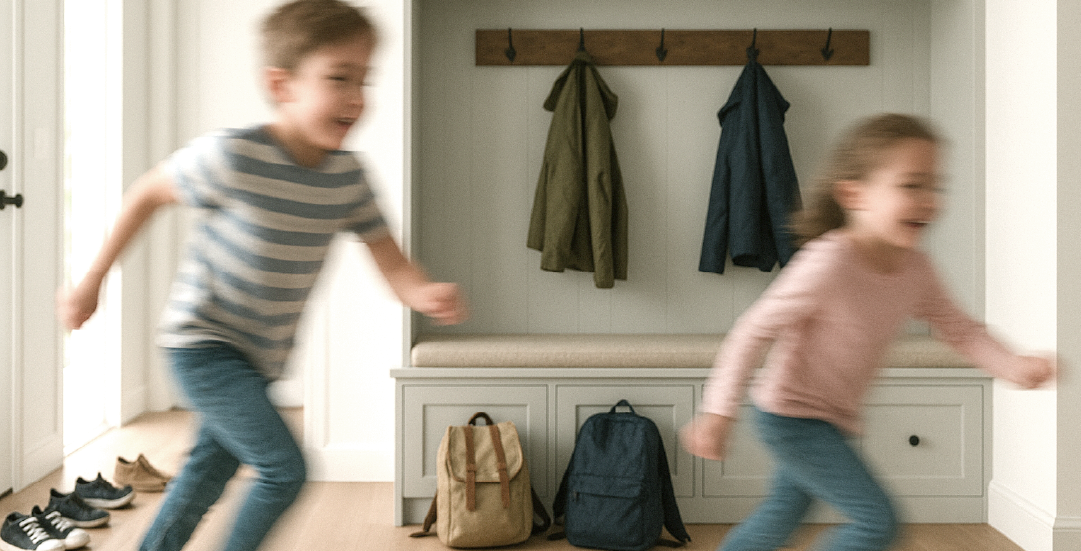Mudroom Cabinetry That Actually Works (Even in a Busy Family Home)
You know the moment. The door swings open. Backpacks hit the floor. A trail of shoes appears in seconds. One jacket makes it to a hook. The rest? Dropped. The dog shakes off water everywhere. You're already thinking about dinner, and now you're stepping over chaos.
The mudroom was supposed to help. Right now, it just feels like a holding zone for mess. And in Edmonton, where you’re dealing with weather changes sometimes multiple times a day, your mudroom absolutely needs to work with you. We’re not dealing with Hollywood style family homes where people simply waltz in from outside and drop their keys in a bowl.
Why Most Mudrooms Don’t Stand a Chance
This isn’t about being disorganised. It’s about design. Hooks are too high. Cubbies are too shallow. Cabinets hold the wrong things, or nothing at all (it’s more common than you’d think). So instead of creating calm, the space becomes one more spot where clutter collects.
We see it in homes of every size. It’s not about square footage, it’s not about how many kids & pets you have. Believe it or not, it’s not even about training your husband where to hang his coat. It’s about systems that match your real-life routines.
What a Working Mudroom Actually Feels Like
It’s not about perfection. It’s about function. A well-designed mudroom doesn’t need tidying every night (we see you, closing routine TikTok influencers). It doesn’t demand baskets that look good but can’t hold what you need. It absorbs the rhythms of your day and gives everything a place to land naturally.
In real life, that means:
- Hooks at kid height (and not located immediately behind the door) so coats go up, not on the floor
- Closed storage with enough depth for sports gear, pet supplies, and off-season extras
- Open cubbies for quick-access shoes that don’t get kicked aside
- A bench you can actually sit on without clearing it off first
- Durable materials that handle weather, grit, hockey bags, and wet paws
Design That Moves Like Your Family Does
Many families think the mudroom just needs better organization - more tupperware bins, wicker baskets, etc. But often, the space you have is trying to solve the wrong problems. You don’t need more storage or more square footage. You need smarter storage that fits your habits.
That’s why we always start with questions.
Who walks in the door first?
What needs to be within reach?
What always ends up in the wrong spot?
From there we design cabinetry that fits how your family moves, not how a catalogue looks. It’s not about styling a space for photos. It’s about building a space that works for your life. Remember, at the end of the day no one cares about your mudroom but you. Skip the insta-worthy decor and make room for life.
Mini Design Tip: Set Zones That Reflect Your Real Flow
Not ready for a reno? You can still work with what you already have. Whether your home features a full mudroom or just a back hallway, try dividing the space into simple zones:
- Drop Zone: Bags, coats, lunch kits. Easy access.
- Grab & Go: Shoes, boots, leashes. Nothing behind a door.
- Tuck Away: Seasonal bins, rarely used gear, extra supplies.
This simple shift can turn even the tightest space into something that works harder for your family and keeps your mornings moving.
What Order Feels Like
It’s not silence or minimalism. It’s just less friction.
The floor stays clear. You can mop without moving piles. The leash is right where it should be. And no one is asking, “Where’s my other glove?”
Order isn’t a look, it’s a feeling that you notice most when things are moving fast.
And no, order isn’t just for big, fancy homes. We’ve built efficient, functional mudrooms into small entryways, tight corners, and even hallway closets. The layout matters more than the size. If the space feels chaotic, it’s not a failure, iIt’s just a sign the design isn’t helping yet.
|

